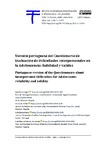Mostrar o rexistro simple do ítem
Versión portuguesa del Cuestionario de evaluación de dificultades interpersonales en la adolescencia: fiabilidad y validez
| dc.contributor.author | Inglés, Cándido J. | |
| dc.contributor.author | Urbán, Dori J. A. | |
| dc.contributor.author | Castanheira, João | |
| dc.contributor.author | García Fernández, José Manuel | |
| dc.date.accessioned | 2022-07-07T21:59:06Z | |
| dc.date.available | 2022-07-07T21:59:06Z | |
| dc.date.issued | 2022-07-01 | |
| dc.identifier.citation | Ingles, C. J., Urbán, D. J. A., Castanheira, J., & Garcia-Fernandez, J. M. (2022). Versión portuguesa del Cuestionario de Evaluación de Dificultades Interpersonales en la Adolescencia: fiabilidad y validez. Revista de Estudios e Investigación en Psicología y Educación, 9(1), 39-57. https://doi.org/10.17979/reipe.2022.9.1.8729 | es_ES |
| dc.identifier.issn | 2386-7418 | |
| dc.identifier.uri | http://hdl.handle.net/2183/31133 | |
| dc.description.abstract | [Resumen] El objetivo de este estudio fue validar la versión portuguesa del Cuestionario de Evaluación de Dificultades Interpersonales para Adolescentes (CEDIA) usando una muestra de 369 estudiantes de 12 a 18 años (51 % chicas; M = 14.50; SD = 1.60). El análisis factorial exploratorio de componentes principales y rotación oblimin, identificó 4 factores relacionados (Asertividad, Relaciones Familiares y Amigos, Relaciones Heterosexuales y Hablar en Público) que explicaron el 43.45 % de la varianza. En el análisis factorial confirmatorio se analizaron tres modelos predefinidos: el modelo nulo (M0), el modelo de un factor (M1) y el modelo de cuatro factores relacionados (M4). M4 fue el modelo que mejor se ajustó a los datos. La consistencia interna y la fiabilidad test-retest para la puntuación total del CEDIA fueron apropiadas. La correlación del CEDIA con la puntuación total del Inventario de Ansiedad Escolar (IAES) fue positiva y con un tamaño del efecto moderado. Este resultado fue similar para los tres sistemas de respuesta de ansiedad escolar medidos por el IAES y algo más variable para las cinco subescalas situacionales del IAES. Además, la correlación del CEDIA con la Social Anxiety Scale for Adolescents (SASA) fue positiva y pequeña para la subescala Aprensión y Miedo a la Evaluación Negativa (AFNE y moderada para la subescala Tensión e Inhibición en Situaciones Sociales (TISC). Finalmente, la correlación del CEDIA con el Internet Personality Inventory (IPI) fue positiva y moderada para la escala de Neuroticismo y negativa y pequeña para la escala Extraversión. | es_ES |
| dc.description.abstract | [Abstract] The aim of this study was to translate and adapt the Portuguese version of the Questionnaire about Interpersonal Difficulties for Adolescents (QIDA) using a sample of 369 students aged 12 to 18 years (51 % girls; M = 14.50; SD = 1.60). The exploratory factor analysis of main components and oblimin rotation, identified four related factors (Assertiveness, Relations with family and friends, Heterosexual relationships and Public speaking) that explained 43.45 % of the variance. In the confirmatory factor analysis (CFA), three predefined models were analyzed: the null model (M0), the one-factor model (M1) and the four-factor model (M4). CFA showed that M4 fit the data best, and internal consistency and test-retest reliability for the total score of the QIDA were appropriate. The correlation of the QIDA with the total score of the School Anxiety Questionnaire (SAI) was positive and with a moderate effect size. This result was similar for the three school anxiety response systems measured by the SAI and slightly more variable for the five situational subscales of the SAI. In addition, the correlation of the QIDA with the Social Anxiety Scale for Adolescents (SASA) was positive and low with the Apprehension and Fear of Negative Evaluation subscale (AFNE) and moderate with the Tension and Inhibition in Social Situations subscale (TISC). Finally, the correlation of the QIDA with the Internet Personality Inventory (IPI) was positive and moderate for the Neuroticism scale, and negative and low with the Extraversion scale. | es_ES |
| dc.language.iso | spa | es_ES |
| dc.publisher | Universidade da Coruña, Servizo de Publicacións | es_ES |
| dc.relation.uri | https://doi.org/10.17979/reipe.2022.9.1.8729 | es_ES |
| dc.rights | Atribución-CompartirIgual 4.0 Internacional (CC BY-SA 4.0) | es_ES |
| dc.rights.uri | https://creativecommons.org/licenses/by-sa/4.0/ | |
| dc.subject | Adolescencia | es_ES |
| dc.subject | Ansiedad interpersonal | es_ES |
| dc.subject | Miedos sociales | es_ES |
| dc.subject | CEDIA | es_ES |
| dc.subject | Adolescence | es_ES |
| dc.subject | Interpersonal anxiety | es_ES |
| dc.subject | Social fears | es_ES |
| dc.subject | QIDA | es_ES |
| dc.title | Versión portuguesa del Cuestionario de evaluación de dificultades interpersonales en la adolescencia: fiabilidad y validez | es_ES |
| dc.title.alternative | Portuguese Version of the Questionnaire About Interpersonal Difficulties for Adolescents: Reliability and Validity | es_ES |
| dc.type | journal article | es_ES |
| dc.rights.accessRights | open access | es_ES |
| dc.date.updated | 2022-07-04T08:25:45Z | |
| UDC.journalTitle | Revista de Estudios e Investigación en Psicología y Educación | es_ES |
| UDC.volume | 9 | es_ES |
| UDC.issue | 1 | es_ES |
| UDC.startPage | 39 | es_ES |
| UDC.endPage | 57 | es_ES |
| dc.identifier.doi | 10.17979/reipe.2022.9.1.8729 |






